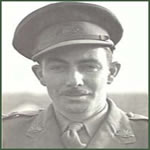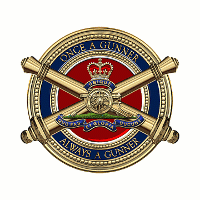 |
|
John William O’Brien was born in Collingwood, Victoria on 13th June 1908. He was the only child of Henry Charles O’Brien and his New Zealand born wife Jen Doris, née Kerr. He was educated at St Patrick’s College, East Melbourne and the Working Men’s College. He gained a Diploma in Civil Engineering at the Royal Melbourne Technical College. He worked in various engineering groups such as Dorman Long Limited from 1925–1928, American Bridge Company, USA, 1929–1930, United Stevedoring Melbourne, 1931-1939, and co-founding Fleet Forge, in 1929. After war service he established Contract Tooling Pty Ltd which ran until his retirement in 1973. He was a Fellow of the Institution of Engineers, Australia.
John O’Brien was commissioned a Lieutenant in the Australian Military Forces in 1928 and studied military history in the United States in 1930. In 1931 he was attached to the Royal Artillery in the UK. |
From 1932 to 1936 he was acting Adjutant of the 10th Field Artillery Brigade and was later made a Battery Commander. In 1937 he was promoted to Major and transferred to Army Headquarters. In 1939 he was appointed Deputy Assistant Director of Artillery. In May 1940 O’Brien joined the Australian Imperial Force (AIF) and was posted to the 2nd/7th Field Regiment as Second in Command (2IC). Serving in Palestine, he was promoted Lieutenant Colonel and appointed to command the 2nd/5th Field Regiment. His military and engineering experience, and his ‘almost youthful dash and enthusiasm’ won him the respect of the regiment. He led the 2nd/5th throughout the Syrian campaign during which he repeatedly came under mortar and sniper fire. At the young age of 32, he was reputedly the youngest commanding officer in the AIF at the time. For his courage, driving power and relentless energy he was awarded the Distinguished Service Order and Mentioned in Despatches.
He advanced through the ranks to Brigadier in 1942 at the early age of 33 years. He was Director of Artillery for the Australian Army 1942–1943 and Deputy Master General of the Ordnance 1943–1945. During 1944 he was on special duty in both the United Kingdom and United States. He was present at campaigns in the Pacific, Western Europe, Italy and Burma during this period. During 1942-1943, O’Brien played a significant part in the development of the QF 25 Pounder Short, which was predominantly designed for use in Jungle Warfare.
In 1945-1946 he led the Australian Scientific Mission to Japan. During 1946-1951 he was, by special arrangement with the Australian Government, Chief of the Scientific and Technical Division at General MacArthur’s Supreme Commander for the Allied Powers (SCAP) Headquarters controlling some 50,000 Japanese qualified scientists. He was also a member of the important Economic Policy Board for Japan 1947-1951.
O’Brien had the honour to be appointed by General MacArthur to the Supreme Commanders War Crimes Tribunal to preside over an otherwise all American court for the trial of Admiral Toyoda, the Commander-in-Chief of the Japanese Imperial Navy. This trial, which lasted nine months, was concerned with command responsibility at the highest levels for all alleged wartime atrocities by the Navy.
He was Senior Supply and Defence Production Representative for Australia in Washington 1951-1954 during the Korean War.
From 1968 he was an Alderman of Woollahra Council and twice Mayor. He was an appointee to the Local Government Appeals Tribunal. He represented Woollahra Council on virtually all major joint committees which concerned the area.
John O’Brien was active in many charities. He was a Councillor of the Royal Blind Society and on the Advisory Board of St Margaret’s Hospital. He was Chairman of Fund Raising for the Edina Foundation and Freedom from Hunger Campaign.
He was author of a military history, “Guns and Gunners”, 1950 which is a history of the 2nd/5th Field Regiment during World War II. He also regularly contributed to journals on military equipment, engineering and Japan.
John O’Brien died on 27 May 1980 at Darlinghurst and was buried in South Head Cemetery. His wife, son and daughter survived him.
Acknowledgements:
O’Brien, John William Alexander (1908-1980) by A. J. Sweeting. Published in Australian Dictionary of Biography, Volume 15 (MUP), 2000.
The Gunners, by David Horner. RAAHC
|


